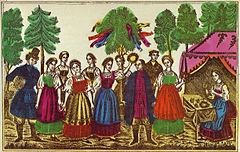| Green week | |
|---|---|
 Semik, lubok, 19th century | |
| Also called | various names in Slavic languages |
| Observed by | Slavic people |
| Begins | Easter + 42 days |
| Ends | Pentecost |
| Date | the week preceding Pentecost |
| Frequency | annual |
| Related to | Pentecost, Trinity Sunday, Eastern Orthodox liturgical days, Rosalia |
Green week, or the green holidays, is a traditional Slavic seasonal festival celebrated in early June. It is closely linked with the cult of the dead and the spring agricultural rites. In Eastern European villages, the seven weeks following Easter have historically been a time of festivity. Green week takes place during the seventh week leading up to the Pentecost,[1] and includes the seventh Thursday after Easter, called Semik.
The green week is followed by Trinity week, also known as the holiday of the Trinity in Eastern Christianity. It is also widely known as Whitsuntide week in the English-speaking world, especially Great Britain, and is inaugurated by the celebrations of Trinity Sunday, the Sunday of Pentecost in Eastern Christianity.
- ^ Sokolov, Yuriy M. (1971) [1950]. Russian Folklore. Detroit: Folklore Associates. pp. 188–195. ISBN 0-8103-5020-3.